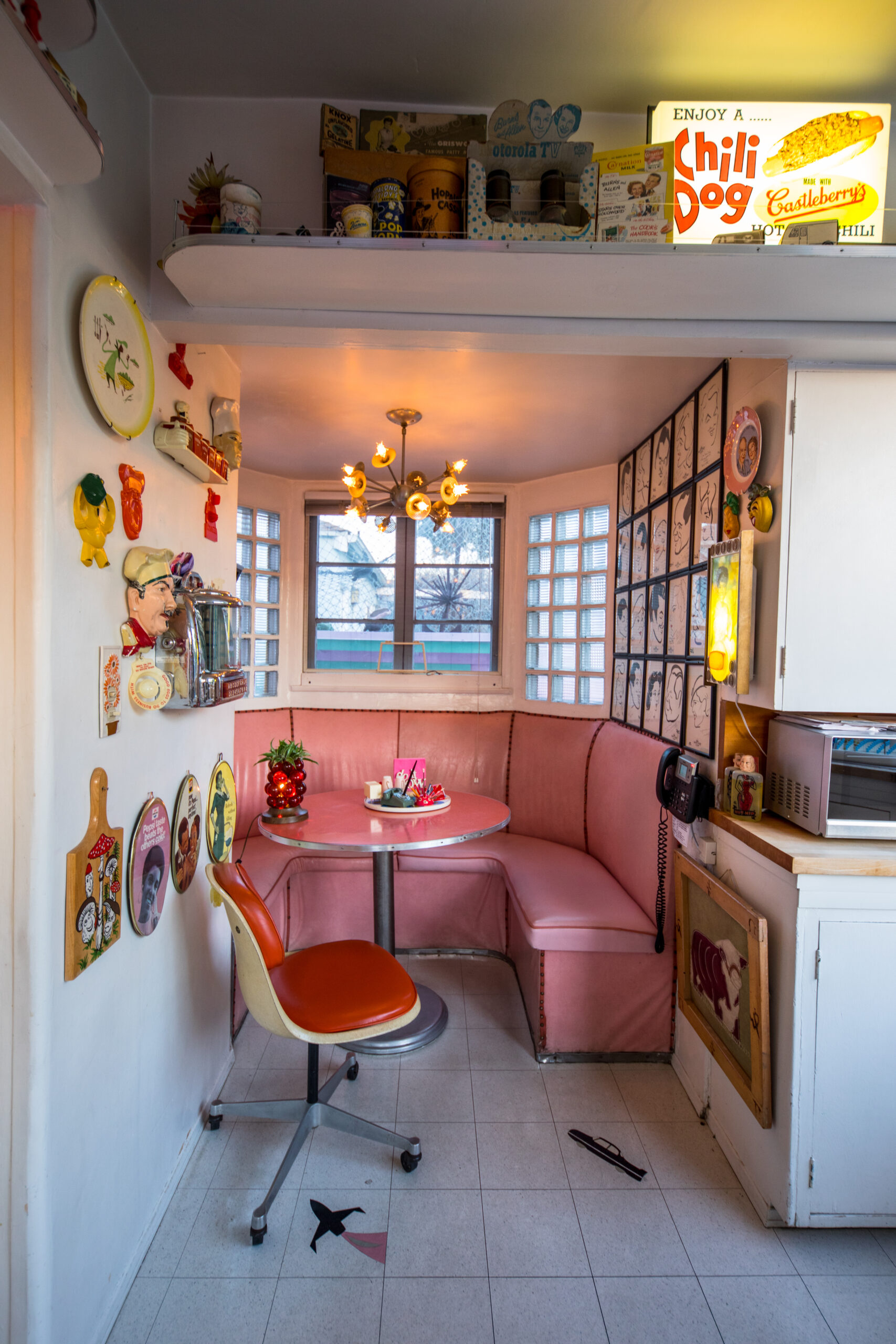Allee Willis
Grammy, Emmy and Tony award-winning and nominated songwriter, ALLEE WILLIS, creates a one-of-a-kind shrine to her Motown roots.
llee Willis points to a vibrant, eye-popping artwork bathed in a ray of sunlight streaming through the large window of her compact, well-laid dining room. "This one is fan art. It's made entirely from junk lying around the house. It's called 'junque drawer portrait' by the artist. And that one over there..." she says, motioning to the opposite wall, "That one is made entirely from jellybeans." Both portraits perfectly capture her likeness, her bold, red lips, her ever-present l.a.Eyeworks glasses, and her fantastically asymmetrical and untamed hair. Her brightly colored, mismatched, partially vintage, and almost entirely eBay-purchased wardrobe complements her house in every respect. This is The Allee Willis Museum of Kitsch, and she is its living centerpiece. Her fans adore her, and there are many of them. At last count, her songs have sold more than 60 million records worldwide.
Best known for her stellar songwriting abilities, Allee has written multiple smash hits, including ‘September’ and ‘Boogie Wonderland’ for Earth, Wind and Fire, the theme song to the television show Friends, and both the music and lyrics for the Broadway hit The Color Purple. For these and others, she has earned a Grammy Award and was nominated for an Emmy Award and Tony Award personally, while The Color Purple earned both a Grammy and a Tony.
She is eclectic and electric. And on the day of our photo shoot, the air feels particularly charged as Allee has just learned, mere hours before, that she will be among the latest round of artists to be inducted into the Songwriters Hall of Fame in June. It is a coveted and exceptional accolade to add to her ever-growing list of accomplishments, the ultimate laurels honoring her and her immense and critically acclaimed body of work. But music must share its space in her heart, for Allee has another passion: all things kitsch.
Over nearly 40 years, she has made it her mission to transform this house into a showpiece for her beautifully curated collection that includes countless African American pop cultural artifacts from the 50s, 60s, and 70s. Out front, the yard’s scattering of bowling balls contributes immensely to the property’s magical, sugar-plum-dream-like quality. Being whimsical, playful, and downright Seussian, the house itself lends itself perfectly to her mission. Situated in the quaint Valley Village neighborhood of the San Fernando Valley, the property was designed by German architect and Schindler/Neutra peer William Kesling in 1937.
Although initially commissioned by Warner Bros. as a guest house, this pied-à-terre doubled as a venue for lavish studio parties. Its front door landing was a small stage overlooking the sunken yard below. Being a masterful party-thrower herself, it is precisely this tradition that Allee zealously upholds. She relishes the opportunity to gather the members of her massive circle of friends from the far reaches of the art, music, and entertainment worlds. The dwelling has every element that Allee needs to fuel her creativity and lifestyle: a recording studio, an artistic office space, and a variety of indoor and outdoor rooms that encapsulate the California Lifestyle.
The house is based on a series of 45-degree and 22.5-degree angled walls, where you are hard-pressed to find a square room. The streamlined moderne and clerestory windows are light and elegant, allowing the sunlight and glow of the pool to bathe the house in color and warmth. The surrounding palm trees and native plants give off a vacation vibe. At the same time, the TV sets, situated in almost every room of the house and both ends of the pool, all turned on at any given moment, remind you that you are sitting smack dab in the center of the Entertainment Capital of the World. Upon purchasing the property in 1980, and with visionary (and perhaps prophesier-like) instincts, Allee made it her first rule of order to paint the entire exterior of the house a light pink hue.
Twenty years later, this decision proved to be more than serendipitous when Alice Walker, the Pulitzer and National Book Award Winning Author of The Color Purple, visited and immediately exclaimed that this was the home of Shug Avery, the protagonist in her story, who had also lived in a pink, rounded house. Allee was the one who was meant to bring Shug’s story to the stage. It had been written in the stars, and the plan had been set in motion nearly two decades prior.
Over the years, Allee has restored the house entirely, room by room, taking it back to its original elegance and beyond. From porthole laundry chutes to hand-carved, inlaid, singing fish in the linoleum floors, there are enchanting details around every corner. Spurred by her penchant for found objects, Allee designed and built much of the furniture throughout the house, often incorporating vintage car parts, such as steering wheels, insignias, and door handles, into her work; a clear nod to her father, a scrap metal dealer, and her beloved hometown city of Detroit.
This coming June, when Allee returns home from New York City
with her Songwriters Hall of Fame trophy in hand, it will no double find its rightful place on her mantel with her various other awards in a compact but well-laid out dining room, next to the strikingly accurate portrait of her, made entirely from household junk.










































